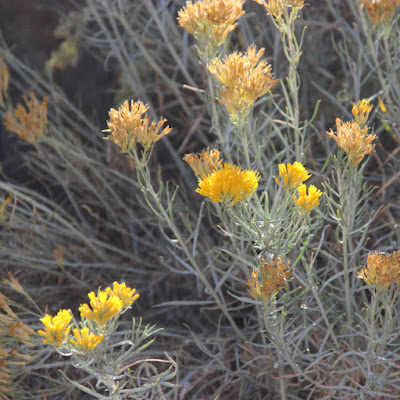Formation on a passive continental margin. Roughly 500 million years ago, much of eastern Nevada was a warm shallow ocean where sand, mud, and limey muck accumulated. With pressure, cementation, and enough time, the sediments became rock—thick layers of sandstone, shale, and limestone. This went on for hundreds of millions of years. Then Nevada's idyllic coastal setting came to an end.
Deformation caused by uplift and intrusion. By about 250 million years ago, the sea had disappeared. It was replaced with land pushed up and contorted due to the jostling of lithospheric plates far to the west. This also caused production and rise of magma, much of which cooled and hardened before reaching the surface. When magma was intruded into the old sedimentary rock layers, they were deformed and often metamorphosed (one reason there are so many productive mines in Nevada).
Deformation due to continental extension. Currently much of western North America is stretching, as it has been for maybe 30 or 40 million years. Nevada is about twice as wide as it was thirty million years ago! The old marine sedimentary rocks have been disturbed once again—uplifted and often tilted. As a result, mountains have risen and intervening land has sunk, forming the Basin and Range Province.
 |
| Northern Basin and Range Province (NPS). The many more-or-less parallel mountain ranges looked like "an army of caterpillars marching toward Mexico" to pioneering geologist Clarence Dutton. |
With my limited background, I found this type of road cut cryptic, even with a guidebook. No matter, I poked around just the same. That's how I came upon this treasure amid the garbage and the flowers (2).
 |
| One of many beer cans for scale. |
The rock exposed here is mostly old limestone that formed when eastern Nevada was a shallow sea. Since then it has been greatly altered. Intruded magma probably played a role, for there is mineralization nearby (copper, silver, lead, zinc, and gold). The limestone also has been subjected to extreme extension, fracturing into huge chunks that moved for miles. In the process, the rock was broken into angular fragments, which were then cemented back into rock in various ways to form limestone breccia ("breccia" is Italian for rubble or rubbish).
 |
| Calcite veins in fractured limestone. |
 |
| Gypsum crystals in the Naica cave, a giant geode. Alexander Van Driessche photo (source). |
 |
| Fragments of limestone with quartz veins in a matrix of ... ?? |
 |
| Red coloration was common, due to iron oxide according to the guideboook. |
 |
| Another puzzling but beautiful spot, with calcite, iron oxide, and an unknown rock. |
And finally, there were flowers. Rabbitbrush, Ericameria nauseosa (many still call it Chrysothamnus nauseosus), was blooming along many roadsides.
NOTES
(1) This is a metamorphic core complex. I visited two on my trip, and may try to put together a post about them, but they intimidate me. It seems they're poorly understood, even by experts.
(2) From Leonard Cohen's Suzanne, a song that will always be with me.
SOURCES
DeCourten, F. 2003. The Broken Land; adventures in Great Basin geology.
DeCourten, F, and Biggar, N. 2017. Roadside Geology of Nevada.
Tingley, JV, and others. 2010. A Geologic and Natural History Tour Through Nevada and Arizona Along U.S. Highway 93. NV Bureau of Mines & Geology.







Thanks so much for the wonderful photos, info, and geology musing! (And for all the pesky plants in previous posts!). I hope you do post more about metamorphic core complexes.
ReplyDeleteThanks, Ingrid. I'm glad you enjoyed it. And thanks for the MCC encouragement ... or should I say "pressure"?! (ha ha, just joking)
DeleteRecognized the channeling of Cohen in the title. That road cut must have taken some time to digest.
ReplyDeleteNice :)
DeleteI had a little help on the road cut, fortunately. But much of it still puzzles me. That's ok, "let the mystery be"